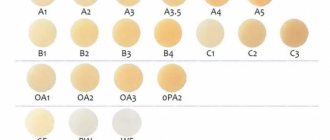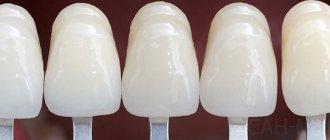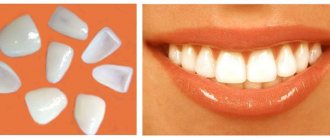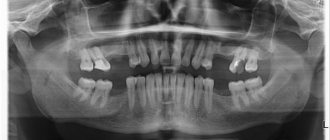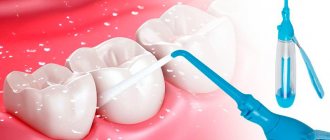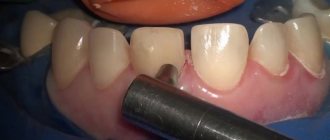To understand which veneers to choose, ceramic or composite, let’s take a closer look at what dental veneers are and what their features are. Veneers are thin plates of ceramic (sometimes zirconium) or composite material that are fixed to the front side of the teeth. Such microprostheses are used to correct aesthetic defects of the dentofacial apparatus and provide additional protection to the enamel. The onlays, made from impressions, imitate the natural shade of the dentition and do not stand out from it.
Veneering straightens the dentition, hides defects (uneven teeth, large interdental gaps, cracks or chips of the coronal shell), simplifies oral hygiene, and serves as an effective means of preventing periodontal diseases.
Author of the article: Meliksetyan Daniel Oganesovich
Work experience:
15 years
Specialization:
Dentist-orthopedist
Works:
at the clinic on Proletarskaya metro station
Differences between composite and ceramic veneers
Veneers made of composite material are otherwise called direct - due to the method of creation. The doctor plays the record in 1.5 - 2 hours while the patient is in the dental chair. In some cases, an impression is taken of the teeth and the veneers are cast from the impression in the laboratory.
Direct veneers are extremely firmly connected to the tooth tissue, this is facilitated by the layer-by-layer technology of applying a composite to damaged enamel. It is impossible to tear the created plate from the foundation. The tightness of the composite veneer is extremely high - there is not the slightest gap between the base and the coating that could provoke the growth of pathogenic flora. At the same time, the composite veneer retains its plasticity and does not cause discomfort. Preserving color and transparency for many years, the prosthesis maintains the impression of the naturalness of the restored tooth.
Ceramic veneers or zirconium veneers are made exclusively in a dental laboratory using high-precision impressions. They are attached to the patient's teeth using a specially developed adhesive. There are several known methods for making ceramic veneers: pressing under pressure, casting on a refractor, cutting from a molded blank. These thin plates in finished form also very reliably imitate the appearance of human enamel, so correcting the aesthetics of a smile with such overlays is always successful.
Life time
Ceramic veneers are more durable than composite veneers. This is determined by the characteristics of the material: ceramics are denser, stronger, and are not subject to staining or changing color or surface texture over time. With proper care, ceramics last for decades. The service life of the composite is limited to five years, which is determined by the properties of the material itself: under the influence of an aggressive environment and mechanical loads, its surface changes, wears out, and becomes porous, which is why the surface of the crown darkens or becomes stained and loses its gloss.
Features of direct veneers
People choose this restoration method for a number of reasons:
- It's inexpensive and fast. Composite veneers are installed in one clinic visit; there is no need to plan long-term treatment or schedule trips to the dentist. The cost of the composite is much lower than the production of ceramics.
- The removal of enamel from the surface of the teeth is extremely minimal, sometimes only required in places.
- There is a clear similarity between composite veneers and the enamel of natural teeth.
- It is attracted by the high adhesion of the artificial material to living tissues.
The technique has some disadvantages:
- The quality of the final composition greatly depends on the experience and qualifications of the doctor. This drawback, however, is inherent in any result of a dentist’s work.
- Tarnishing of a record over the years. It can be eliminated by polishing the veneer once every six months.
- Changes in the color of the veneer due to frequent consumption of coloring foods and drinks. Cannot be corrected.
- Corrosion of a composite veneer under the influence of ethanol occurs with regular drinking of alcohol and when rinsing the mouth with alcohol-containing rinses.
What to choose
The main advantage of composite restorations over porcelain structures is their lower price and the ability to reduce the time spent on their installation. However, this advantage can no longer be called relevant today, since technologies have appeared that make it possible to install ceramic overlays in a day.
Reviews from doctors and patients indicate that veneering eliminates dental defects, but composites are less able to imitate the natural shade and structure of the enamel. The disadvantage of composite onlays is their inaccurate fit to the tooth surface, which causes the accumulation of bacterial plaque, increasing the risk of developing caries and periodontal inflammation.
The choice of veneering type depends on the number of restorations planned, the need for additional treatment and other factors.
Composite veneers are an excellent solution for the restoration of 1-2 teeth. But if there are problems in the entire frontal area, it is better to install orthopedic ceramic overlays.
Pros and cons of ceramic veneers
The advantages of silicon oxide overlays are obvious:
- Lack of ability to oxidize, change color, or degrade. Ceramic veneers do not absorb pigments from food and do not disintegrate under the influence of acids and alcohols. They will not show any stains or discoloration throughout their entire service life.
- Ceramic veneers will last for more than a decade if initially installed correctly and handled with care.
- The plate is very durable, despite its microscopic thickness, not reaching even a millimeter.
- Imitation of enamel is the best among other veneering techniques.
Flaws:
- The cost of ceramic veneers is not affordable for every patient.
- The impossibility of quick prosthetics sometimes becomes extremely difficult. A person will have to visit the clinic at least twice: to take impressions and for final installation. In addition, you will have to spend money on making a temporary structure, which will need to be worn until the permanent veneers are glued.
- When preparing teeth for veneers, the doctor may overheat the tooth pulp, which can lead to inflammation and acute toothache.
Porcelain veneers require grinding down of the teeth. Composite veneers do not have high strength and durability. There is a better alternative to all options: install veneers without grinding your teeth Luxneers
Material
Ceramics is used for aesthetic restoration because it is as close as possible in optical properties and appearance to tooth enamel. The surface texture, light reflection, and the degree of transparency of the material are such that the restored crowns look natural.
Dental composite is more often used for filling and functional restoration of crowns. It is used less often in aesthetic restoration: it is not so transparent, the surface texture can change over time (become porous, less smooth). Composite reflects light differently than enamel. Because of all this, it does not look as natural, especially on the upper incisors, for which veneering is most often used. They can stand out and attract attention.
Ceramics and composite differ in strength and durability:
- ceramic plates do not wear off and are resistant to chips, microcracks, and other mechanical defects;
- the composite is not so durable: even with careful handling, it gradually deteriorates and requires regular polishing and periodic re-restoration.
Another selection criterion is color. The color of the installed veneers must exactly match the patient’s own enamel. When using ceramics, the shade is selected with maximum accuracy using a special color scale. For composite compositions there are fewer color gradations, which makes it more difficult to accurately select a shade.
After installation, the plates should not be stained by drinks, foods or darken over time. Ceramics are resistant to color changes: the structure of the material is dense, without pores on the surface, it does not absorb pigments or dyes. The density of the composite is lower. Gradually its color may change; it will stain faster than enamel. Because of this, the restored crowns will differ in appearance from the rest of the teeth.
Reasons for installing veneers
If one or two teeth require restoration, it is more profitable to install composite veneers, but ceramics are not at all prohibited. If there are many cosmetic defects and you need to cover three or more teeth, it is advisable to use porcelain veneers.
General indications for veneering:
- Masking darkening of enamel, the presence of erosive areas, small chips and cracks, stains.
- Correction of hypersensitivity of teeth.
- Improving the appearance of the tooth after treatment of pulpitis or caries. Behind the veneer, like behind a shield, it is possible to hide fillings and tooth darkening as a result of nerve removal.
- Changing the shape of the tooth, giving the effect of uniformity in the row.
- Covering interdental spaces and wide crevices.
When choosing to improve the aesthetics of your smile with veneers, you will have to follow the instructions of your dentist. The doctor has the right to refuse to place veneers on the patient if the following diseases are traced in the anamnesis:
- Bruxism (uncontrollable night grinding of teeth);
- Deformation of gum tissue, periodontal disease, gingivitis, poor sanitary condition of the oral cavity;
- Too massive fillings on the teeth, exceeding the volume of remaining living tissue;
- Malocclusion;
- Allergy to components of the composite mass.
Do you still think that veneers without grinding of teeth Luxneers or composite are better?
Make an appointment
Or call +7(985)532-21-01
Production stages
Composite plates are very quickly installed on damaged teeth. This is explained by the special properties of the material (coposite), as well as the technology for manufacturing the plates and their installation:
- The tooth is lightly ground (the thickness of the removed enamel is 0.3-0.7 mm);
- A special cord is installed between the tooth and the gum to avoid damage to the gum;
- The oral cavity is rinsed with a special solution and dried;
- Next, the dense substance of the composite is applied in layers, each layer is fixed with ultraviolet light;
- The resulting result is leveled and polished.
It must be said that every six months it is necessary to do grinding to maintain their aesthetics.
Rules of care
Modern dental ceramics are as durable as natural tooth enamel. Therefore, you shouldn’t be afraid to treat yourself to nuts or grilled sweets once again, just don’t open bottles with your teeth, and use mouthguards when doing active sports.
Another thing is composite linings. To extend their service life you will have to:
- stop smoking, otherwise your teeth will quickly turn yellow-brown;
- give up coloring foods: beets, wine, strong tea, fresh berries, coffee;
- Use cavity rinses that do not contain ethanol.
Abrasive toothpastes are contraindicated for both ceramic and composite veneers. To restore the smoothness of composite onlays, it is enough to visit the dentist once every 6-12 months for grinding.
Despite the fact that plaque does not form on ceramic linings, regular professional cleaning, at least once every six months, is also necessary in this case. But you need to trust your smile only to professionals!
Remember! Ultrasonic and popular abrasive methods of cleaning teeth Air Flow are strictly prohibited for patients with ceramic veneers. Both procedures violate the integrity of the plates.
Any problems with both composite and ceramic veneers require increased attention. Roughness and steps at the point of contact between the prosthetic material and tooth enamel cannot be ignored. If the veneer is not installed tightly, it may fall off at the most inopportune moment. And any, even the smallest, gap is a gateway to infection and a serious risk of developing caries.
Gums require no less attention. In areas of contact with veneers, they may bleed, swell, and hurt. It is dangerous to ignore such symptoms: in the case of a chronic inflammatory process, the doctor will be forced to remove the linings and start the entire restoration process all over again. To prevent this from happening, at the slightest irritation, make an appointment with a dentist you trust.
Indications for installation of overlays
Composite onlays will help correct any minor enamel defects and aesthetic imperfections of the smile:
- chips;
- enamel irregularities;
- microcracks;
- large gap between the front teeth;
- old darkened fillings;
- stains on teeth that cannot be whitened.
If the patient is categorically not satisfied with his smile, ceramic veneers will be a more effective solution. With their help, you can radically change the situation: create a Hollywood smile, correct wedge-shaped teeth, crowded incisors, and correct your bite. The installation of ceramic veneers is also recommended for worn-out tooth enamel, as well as for too small teeth.
Stages of restoration and restoration of teeth
- Preparation. Includes examination of the oral cavity and hygienic cleaning. It is necessary to determine the natural color of the patient’s teeth, and not the color of deposits, and to select the appropriate material to match it. In addition, there should be no dental deposits between the tissues and the restoration material so that they do not interfere with adhesion (adhesion to the surface).
- Tooth treatment. Old fillings are removed. Depulpation (nerve removal) and root canal filling are performed, if necessary. Grind the tooth to the required size. An impression for the microprosthesis is taken from it and sealed with a temporary filling or temporary veneer (only for the indirect method).
- Restoration. Photopolymers are applied layer by layer until the desired shade and transparency are achieved. They form the correct shape (for the direct method). Try on and install an inlay or veneer (for the indirect method).
- Finish polishing. A dental bur is used to remove excess restorative material so that it does not disturb the bite. The restored areas are sanded to give them a natural shine.
Dental restoration
When the dentition is destroyed, the enamel is damaged or irreparably changed color, the dentists at the GDenta clinic recommend aesthetic dental restoration.
This procedure allows you to completely restore the damaged area, return a beautiful and natural smile, and with it the ability to bite and chew solid food freely. Dental restoration is the general name for methods and technologies aimed at restoring the appearance and functions of the dentition. For each patient, the dentist draws up an individual treatment plan and selects the optimal method. Experienced GDenta doctors take into account the location of the damaged fragment: upper or lower dentition. The condition of the oral cavity and the presence of concomitant diseases in the patient are also important.
The price of dental restoration depends on the chosen method, materials and complexity of therapy. However, our dentistry offers affordable prices, because we are confident that patients should not delay therapy due to financial issues. That's why we also offer interest-free installments for services.
How to make a choice?
As you can see, composite and ceramic veneers differ significantly from each other, having a considerable number of features. When making a choice, it is important to take into account all factors at once, from the severity, volume and type of lesion to financial capabilities.
Highly qualified dentists at the Apex clinic will always advise you on the optimal method for restoring teeth in your particular case. Within the walls of our clinic, they will always meet you halfway and be able to offer truly effective smile correction methods that meet all your requirements and expectations!
How long can composite veneers last?
The service life of these veneers is short and equal to five years. After this period, the veneers require their renewal. But even during the operational period, you will have to periodically visit the dentist to polish the product.
Read more about the disadvantages of veneers
Service time also depends on other factors. For example, careful daily hygiene procedures. In addition to toothpastes and a brush, you will need to use dental floss and an irrigator - a device that supplies water under pressure. This helps get rid of food debris and plaque in places that are hard to reach with a toothbrush.
The following operating rules will help extend the service life:
- Always monitors the condition of the gums in places where they come into contact with the lining. Discomfort and redness should serve as a signal to immediately visit a doctor.
- Promptly remove dental plaque, which provokes the development of caries. At the first suspicion of caries, the lining is removed in order to carry out appropriate treatment.
- Often, after installation of composite plates, the patient’s diction is impaired. You should not put foreign objects in there. To make the adaptation period go faster, you need to talk more.
- We must not forget about the mechanical impact on the plates. To avoid accidental damage, do not bite or chew hard foods.
Many experts also advise taking care of veneers at night and during activities that involve extreme sports. For this purpose, protective mouth guards are put on before going to bed or exercising.
Characteristic
Composite veneers are presented in the form of a thin overlay that is placed only on the front side of the incisor. With their help, they perform a kind of artistic restoration of the tooth, which is located in the smile zone.
Veneers are made using composite reflective materials, which are applied layer by layer to the incisor. The entire manufacturing process takes place immediately in the oral cavity, right there in the office of a specialist (dentist). To correct tooth errors with the help of composite veneers, one appointment will be enough, which is why this method of restoration has received a second name - therapeutic.
Since the front part of the tooth is subject to minimal pressure and abrasion during food intake, such plates can last quite a long time. Their service life can be increased through proper care and compliance with certain operating rules, which we will consider later.
How much do veneers cost in Krasnoyarsk?
If you conduct a comparative analysis of prices for services from various dental clinics in our city, you will see significant differences. We do not undertake to speak for other institutions, but we can say with confidence that the prices of the Apex dental clinic are fully justified by the quality!
Here you can get veneers on your teeth from really good specialists with impressive experience! Here you can consult for free on all issues, receiving the necessary recommendations from doctors. And here, dental veneers cost on average from 8,000 to 22,000 rubles (the price is current at the time of writing the article; for clarification, please visit the appropriate section of the site or contact the managers of our clinic at the specified phone numbers).
Making your smile perfect is easy with the Apex dental clinic!


